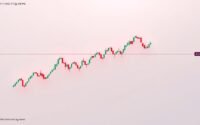Why the Next Bitcoin Bear Market Will Be the Worst Yet: Future Outlook
Surprising fact: bitcoin climbed from about $16,000 in 2022 to a fresh high near $109,354 after a long consolidation below the March 2024 peak of $73,835.
This piece assesses why-the-next-bitcoin-bear-market-will-be-the-worst-yet could happen despite a powerful bull run. We use current-cycle data: ETF flows swung from heavy outflows in early 2024 to neutral around zero, then flipped to inflows from April 21. Long-term holder supply rose from ~61.7% to 63.61% by April 2, signaling renewed accumulation.
We map clear levels to watch: $79,900 support, $102,000 resistance, the prior high at $109,354, and the $60,000 region for deeper pullbacks. The focus is on structure, liquidity, and sentiment — how tight markets and overshot prices can turn routine selling into disorderly de-risking.
This is informational research, not investment advice. Read on for evidence-based scenarios, timelines, and practical markers U.S. investors should monitor as volatility and risk rise in the broader crypto market.
Key Takeaways
- Bitcoin’s surge to ~$109,354 masks late-stage fragility in market structure and liquidity.
- ETF flows shifted from large outflows to meaningful inflows by April 21, altering demand dynamics.
- Rising long-term holder supply shows accumulation but can also reduce liquidity during sell-offs.
- Watch $79,900, $102,000, $109,354, and the $60,000 area for potential reversal points.
- We connect on-chain, derivatives, and macro signals to outline likely timelines and risks.
From Secular Bull to Cyclical Shock: Framing Bitcoin’s Market Cycle
The long arc matters: since the Great Recession, policy and liquidity have underpinned a secular rise in digital and risk assets. That backdrop explains how bitcoin moved from near-zero to repeated new highs over years.
But a secular advance does not remove shorter shocks. Cyclical drawdowns—sharp 20%+ moves—still punctuate the trend. These episodes often follow shifts in the federal funds rate, liquidity, or investor positioning.
Secular forces vs. cyclical drawdowns
Quantitative easing and loose conditions created a long-run tailwind for stocks and crypto. Yet when rates rise or liquidity tightens, demand falls fast and supply can overwhelm market depth.
How crypto market structure amplifies volatility
- 24/7 trading and fragmented venues mean price moves never pause, which widens swings and shortens recovery time.
- Leverage and futures expand both upside and downside. Backwardation or rising funding rates often signal stress.
- Smaller market size and shallow liquidity make the crypto market more prone to overshoots than the stock market.
Recognizing that secular support coexists with cyclical risk helps U.S. investors avoid mistaking a late-stage bull surge for a durable new expansion. Watch demand, supply, breadth, and macro conditions to judge if a shock is forming.
why-the-next-bitcoin-bear-market-will-be-the-worst-yet: Core Thesis and Investor Context
Late-cycle signals suggest the most dangerous sell-offs often arrive when headlines and prices feel unstoppable. A final push to an all-time zone near $109,354 can look like broad strength while internal measures fray.
The present cycle shows mixed data: ETF flows swung from heavy outflows in March to notable inflows from April 21, and long-term holder supply rose to about 63.61% by April 2. These facts point to accumulation, but they can also thin available liquidity.
Narrative strength can mask deterioration. History shows tops near bullish news and bottoms near bearish headlines. That pattern means strong sentiment and positive news do not guarantee sustained direction.
- Core thesis: late-stage structure and sentiment can produce a harsher phase as secular gains meet weaker internals and shifting liquidity.
- If momentum stalls above key resistance and demand cools, the unwind can be fast and deep, hitting multi-month supports.
- U.S. investors should set scenario plans now—position sizing, stop rules, and hedges—rather than reacting after liquidity thins.
Technical Signals Flashing Red: Indicators, Trend Structure, and Futures Clues
Several technical gauges point to late-stage exhaustion even as prices push new highs. This section groups the key indicators traders and long-term U.S. holders should monitor.
Trend strength and exhaustion
Higher highs on waning momentum and falling volume are classic warning signs. ADX trending down toward 20 often marks a mature trend that can lose its grip.
Elliott Wave and pattern risk
Analysts note a five-wave advance off the 2022 low. The vertical move from Oct 2023–Mar 2024 fits a third-wave blow-off, while the recent high looks like a low-energy fifth wave.
Ending diagonal and bear precursors
An ascending wedge or ending diagonal near the peak implies a deep retracement is possible. Watch for death cross setups, backwardation in futures, and thinning breadth/volume.
- Key levels: $79,900 support, $102,000 breakout gate, $109,354 high, and $60,000 downside magnet.
- Futures basis and open interest shifts often foreshadow stress; backwardation plus OI washouts signal rapid risk-off moves.
- Predefine position rules and momentum triggers rather than reacting to headlines during fast reversals.
Macro, Rates, and Liquidity: Why Conditions Can Magnify the Next Drawdown
When interest rates stay elevated, small shocks can cascade through thin markets and become major drawdowns.
Federal funds and tightening cycles
Higher-for-longer federal funds raise discount rates across risk assets. That compresses valuations and narrows the margin for error in a late-stage bull market.
Pathway from rate sensitivity to demand shocks
As borrowing costs rise, marginal buyers step back. In crypto, thinner order books mean modest selling can become a large price move.
Government, regulation, and headlines
Friendly government news can lift sentiment. But history shows narrative peaks often align with cycle tops, not durable gains.
Stock correlation and cross-asset risk
When the stock market falls, crypto often follows. In 2024, bitcoin lagged the NASDAQ-100 for months, highlighting vulnerability even amid bullish news.
- Watch rates, policy signals, and equity breadth as leading context for crypto risk.
- Plan execution: wider spreads and higher volatility increase slippage and make exits costlier.
Sentiment vs. News: The Contrarian Trap at Cycle Peaks
Markets can cheer big announcements while the real pressure builds quietly behind the scenes.
History shows that major bullish milestones often align with tops, not durable inflection points.
Narrative milestones and reversals
2017: CBOE futures launched on December 10, 2017, near a market high.
2021: Tesla’s February purchase and El Salvador’s September adoption coincided with lofty prices and intense media coverage.
2022: The FTX collapse on November 11 marked a washout low before recovery began.
Flows, volume, and positioning
ETF flows offer a clear positioning lens. Daily outflows peaked on March 10, 2024.
Flows moved to neutral around zero, then shifted to meaningful inflows from April 21. That change signals stabilization, not a guaranteed breakout.
- Sentiment can be euphoric at highs while breadth and volume thin.
- Good news from government or industry can lift headlines but not confirm broader participation.
- Use flows and price structure to judge whether risk is compressing or expanding.
| Event | Date | Signal | Outcome |
|---|---|---|---|
| CBOE futures launch | Dec 10, 2017 | Bullish headlines | Top near highs, sharp reversal |
| Tesla balance-sheet buy | Feb 2021 | Media-driven rally | Prices peaked, volatility rose |
| El Salvador adoption | Sep 2021 | Government news | Short-term highs, mixed breadth |
| FTX bankruptcy | Nov 11, 2022 | Bearish shock | Washout low, recovery followed |
Takeaway: treat positive news at cycle highs with caution. Rely on ETF flows, volume, and price action to measure true momentum over the coming months. A process-based approach limits emotion-driven mistakes in a fragile market.
On-Chain and Market Microstructure: Supply, Demand, and Holder Behavior
On-chain flows and holder behavior now offer a clear window into how supply may compress or erupt in the coming months.

Long-term holder supply and address growth
The share of coins unmoved for over a year climbed from about 61.7% to 63.61% by April 2. That rise signals accumulation and a smaller active supply that can cushion some corrections.
New address creation dipped when ETF access widened, then recovered during the correction. Even the weakest recent reading stayed 17% above last summer’s baseline, showing renewed grassroots demand.
Liquidity pockets, levels, and volatility flow-through
Thin active supply helps prices hold but also makes the market fragile. When order books are shallow, bids and offers get swept quickly and volatility spikes.
ETF flows shifting from outflows to inflows by April 21 support a neutral demand backdrop. That setup can precede one final push in a bull market, but confirmation needs price action and breadth.
“Monitor long-term holder metrics, realized profits, and spot versus derivatives activity to find where liquidity pockets live.”
| Metric | Recent Reading | Implication |
|---|---|---|
| Long-term holder share | 63.61% (Apr 2) | Reduced circulating supply; higher resilience but thinner liquidity |
| New addresses (non-zero) | ~17% above baseline | Recovering grassroots demand; supports market participation |
| ETF flows | Outflows → Inflows (Apr 21) | Neutral to supportive demand; needs price confirmation |
Practical takeaway: U.S. investors should use on-chain context to time sizing and exits. Watch supply restraint, order-book depth, and flows to spot where liquidity could fail or firm up.
Levels, Timelines, and Scenarios: Mapping the Next Move Before a Major Bear
Map clear price points now to decide whether this bull run ends with a short top or one final extension. Set levels and time windows rather than guessing direction from headlines.
Key levels: respect $79,900 as pivotal support, $102,000 as the first breakout gate, and $109,354 as the high that must flip to support for a sustained advance.
Immediate topping risk
If bitcoin fails to hold $102,000 after a breakout and loses $79,900, expect downside toward the $60,000 region over the coming months. This path is more likely if rates rise or liquidity tightens and stock markets wobble.
Extension to $120k+
A clean move through $102,000 and a decisive reclaim of $109,354 can launch a final leg to $120,000+. That advance will likely occur on thinner breadth and selective leadership. Use strength to trim exposure, not add full size.
Time horizons and cadence
This phase may play out over months. A larger bear, if triggered, can unfold over a year or more with intermittent bounces that trap buyers near the peak.
Actionable map: define entry, stop, and trim points around each level and watch momentum and volume for confirmation of direction.
| Scenario | Trigger Levels | Likely Timeframe | Investor Action |
|---|---|---|---|
| Early top | Failure at $102k → break $79.9k | Weeks → months | Reduce risk, tighten stops, hedge |
| Final extension | Clear $102k & hold $109.3k | Months | Trim into strength, preserve capital |
| Bear phase | Loss of $79.9k → path to $60k | Months → year+ | Scale defensive allocations, use options/futures |
Risk Management Playbook for U.S. Investors in a Late-Stage Crypto Market
Define rules before markets move fast: a written playbook is the best defense in a late-stage cycle.
Position sizing, stops, and profit-taking
Set predefined entries, trims, and exits tied to clear prices. Use the key levels—$79,900, $102,000, $109,354, and the $60,000 area—to place stops and take-profits.
Size positions smaller into uncertain breakouts and scale up only when momentum and breadth confirm the move. That limits risk and preserves capital over months.
Hedging tools and cash buffers
Use protective puts around event windows, or futures overlays to cut beta quickly. Keep a cash buffer to buy dislocations or reduce drawdowns.
- Confirmation checks: volume expansion, momentum breadth, and sustained closes above levels before adding.
- Execution: staggered orders and diversified venues to reduce slippage and operational risk.
- Portfolio: blend crypto with other assets and adjust exposure as indicators shift.
Practical rule: write your plan, test it to the current market, and follow it when headlines and prices diverge.
Conclusion
A credible final leg remains on the table, but internal stress and thin liquidity raise clear risks for U.S. investors.
The setup shows a mature uptrend with signs of exhaustion and a plausible five-wave extension to the $109,354 zone. ETF flows flipped to inflows by late April and long-term holder supply rose into early April, which can permit one more push in prices while thinning available liquidity.
Do not let bullish news near highs override weakening internals. Watch $79,900, $102,000, $109,354, and the $60,000 area closely and judge the quality of any breakout by volume and breadth.
Policy, rates, and cross-asset moves will shape conditions over the coming year. Stay disciplined: set rules for entries and exits, align time horizons with strategy, and let process—not sentiment—guide action when the next stressful moment arrives.
FAQ
What makes the next Bitcoin bear market different from prior drawdowns?
The upcoming decline may combine tighter Federal Reserve policy, higher real interest rates, and stronger stock-crypto correlation with structural weaknesses specific to crypto markets—thin liquidity pockets, large concentrated holder selling, and greater use of leverage in futures and derivatives. Those factors can deepen and extend losses compared with past cyclical pullbacks.
How do secular forces since the Great Recession interact with cyclical crypto declines?
Secular trends—such as prolonged monetary stimulus and growing institutional adoption—supported long-term demand. But when monetary policy tightens and risk appetite wanes, cyclical shocks convert that secular momentum into rapid re-pricing. In crypto, this flip can be faster because retail flows, headline-driven narratives, and leverage amplify moves.
Which market-structure features magnify Bitcoin’s volatility and trend persistence?
Key amplifiers include low on-chain liquidity at certain price bands, concentrated supply held by a small set of addresses and institutions, high derivatives open interest, and order-book fragility on spot exchanges. These elements cause larger price gaps, prolonged trending, and sharper reversals than in many traditional assets.
What technical indicators are flashing red for Bitcoin today?
Warning signs often cited are a weakening ADX (showing oscillating trend strength), momentum divergence when price makes higher highs but momentum falls, and classic moving-average crossovers like a sustained death cross. In futures markets, backwardation and funding-rate spikes also signal stress.
How could Elliott Wave or ending diagonal patterns signal late-stage risk?
If price action fits a late-stage five-wave advance or an ascending wedge (ending diagonal), it typically precedes sharp corrections. These patterns suggest exhaustion among buyers and higher probability of a deep retracement rather than a simple pullback to trend-support levels.
What macro variables would most likely magnify a crypto downturn?
The main drivers are rising policy rates from the Federal Reserve, declining liquidity in credit markets, and negative surprises in inflation or employment that push risk assets lower. A synchronized global tightening cycle or a U.S. recession would increase demand shocks and reduce capital available for speculative assets.
How much can government actions and regulation influence the next decline?
Policy headlines—SEC decisions on ETFs, tax rule changes, or enforcement actions—can trigger quick sentiment swings. While not always causal to long-term trends, regulation raises uncertainty, can constrain flows, and sometimes accelerates deleveraging when combined with weak macro conditions.
Why does correlation with equities matter for Bitcoin risk?
When Bitcoin moves in lockstep with stocks, it loses some of its diversification value. In a broad market selloff, simultaneous liquidation across equities and crypto forces higher drawdowns as institutional and retail participants reduce risk exposure across portfolios.
How have narrative tops historically shaped crypto peaks and busts?
Bubble narratives—like the 2017 futures excitement, 2021 corporate and sovereign adoption headlines, or the FTX collapse—tend to coincide with extremes in sentiment and position concentration. Those narratives attract fresh buying that exhausts available supply and sets the stage for abrupt reversals when reality resumes.
What do ETF flows, exchange volume, and positioning tell us about risk?
Heavy inflows and rising retail volume typically signal froth. Conversely, outflows, falling spot volume, and elevated derivatives short squeeze risk can precede sharp moves. Monitoring open interest, funding rates, and on-exchange balance changes helps gauge how vulnerable the market is to a liquidity-driven crash.
What on-chain signals should investors watch for supply and holder behavior?
Important metrics include long-term holder net position changes, increases in coins moving to exchanges, declining accumulation by smaller addresses, and growth in new active addresses. A sudden shift from accumulation to distribution often precedes notable price weakness.
How do liquidity pockets and order-book depth affect BTC volatility?
Shallow order books at key levels cause larger slippage on market orders. If stop-loss clusters sit near thin liquidity zones, cascading liquidations in futures can trigger rapid sell-offs that push price far beyond technical supports before buyers re-emerge.
Which price levels are critical to watch as potential triggers or supports?
Traders often cite local resistances near 2k–9k and a psychological 0k target if momentum continues. On the downside, intermediate support near .9k and deeper zones around k serve as key levels where long-term holders or institutions may step in. Breaches of these zones change market structure and risk profiles.
Could Bitcoin still spike to a new high before a major reversal?
Yes. Markets sometimes produce a final thrust—driven by late entrants, ETF-driven demand, or a short squeeze—that reaches a new peak before a substantive trend reversal. That final leg often carries high sentiment risk and precedes deeper corrections.
What timeframes should investors consider when mapping the next major bear?
Short-term topping and liquidation phases can unfold over weeks to months. Broader cycle shifts—from peak to multi-year bear—often play out over several quarters to years. Investors should align position sizing and hedges with their intended horizon.
What practical risk-management steps should U.S. investors use in a late-stage market?
Use defined position sizing, set stop-loss levels or partial profit-taking thresholds, and avoid overconcentration. Maintain a cash buffer and consider diversified hedges such as inverse futures, put options, or stablecoin allocations to manage drawdown risk.
Which hedging tools are most effective for retail and accredited investors?
Retail investors can use exchange-traded Bitcoin futures and listed options where available to cap downside or lock in gains. Accredited investors may access structured products, OTC options, or dynamic hedging strategies. All hedges have costs and counterparty risks that should be carefully weighed.
How should investors interpret high volatility and funding-rate signals?
Elevated volatility and extreme funding rates typically indicate crowded positioning. Positive funding spikes signal strong long-side leverage that can reverse quickly in a deleveraging event. Monitoring these indicators helps anticipate sharp drawdowns and liquidity squeezes.
When should investors reduce exposure versus when to hold through volatility?
Reduce exposure when technical structure breaks (e.g., sustained close below key supports), leverage metrics spike, and macro signals deteriorate. Hold when fundamentals and long-term thesis remain intact, on-chain accumulation persists, and valuations align with risk tolerance. Decide rules in advance to avoid emotion-driven trades.


